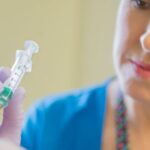Feeling down after a needlestick injury? You’re not alone
Needlestick injuries (NSIs) may have potentially severe consequences on the mental health of injured healthcare workers (HCWs)1. Even though, the physical effects of this type of injury are well-known and documented in medical literature, less attention has been paid to the psychological consequences2.
Four psychological consequences of NSI
1. Occupational stress
According to a prospective observational study published in 2014, Wicker et al. found that stress was a major factor leading to NSIs3. Following an NSI, injured HCWs exhibit higher rates of stress than those without NSIs4. A past NSI may lead to a future one because of the increased stress4.
2. Anxiety
Anxiety among HCWs also increases following an NSI3. The main cause of anxiety reported by HCWs was the fear of human immunodeficiency virus (HIV) transmission5. However, the incidence of occupational transmission for hepatitis B (30%) and C (3%) are much higher than for HIV (0.3%)4. Some HCWs report feeling anxious for up to one year after the injury6.
3. Depression
Psychiatric illness following NSIs have major impacts on work attendance, family relationships and sexual health. Levels of depression may increase in HCWs following an NSI4. Medical students who are already depressed may see their depressive symptoms worsen after experiencing an NSI7,8.
It is important to keep in mind that psychiatric disorders in workers who experience an NSI is similar in severity to other trauma-related psychiatric illness2.
4. Post-traumatic stress disorder
The stress and anxiety following exposure to NSIs may become chronic, leading the injured HCW to develop symptoms of post-traumatic stress disorder (PTSD)9. These symptoms may include detachment and irritability2.
The incidence of PTSD in the general population has been estimated at 3%9. According to the results of a study by Naghavi et al. published in 2013, the incidence of PTSD among trainee doctors following an NSI was 12%9.
The risk of psychiatric disorder should be managed by occupational health doctors to prevent effects on absence, productivity or social functioning2.
More on this topic: Needlestick injury safety, according to an occupational hygienist
Increase in NSIs due to COVID-19
A survey conducted by IPSOS MORI, commissioned by the European Biosafety Network (EBN), has revealed that COVID-19 has caused an estimated increase in the number of sharps injuries to healthcare workers in Europe by 276,000 (23%) in the year 2020. An overwhelming majority (98%) of the respondents also said that the rise in the number of sharps injuries was because of increased pressure and stress due to COVID-19.
Three ways to prevent NSIs
1. Stress prevention training
In a retrospective observational study published in 2016, d’Ettorre found that organisational interventions for the prevention of occupational stress helped to significantly reduce the incidence of NSIs in the hospital studied10.
2. NSI prevention training
During a randomised controlled trial by van der Molen et al., a workshop was given to HCWs on the prevalence, causes, consequences and prevention of NSIs11. They observed a 21% reduction in the incidence of NSIs when compared with HCWs who hadn’t attended the workshop11.
3. Choice of vascular access device
In the same study by van der Molen et al., when NSI prevention workshops were combined with the introduction of a new injection needle with safety device, NSIs were reduced by 64% when compared with the control group11. When compared with conventional devices, safety-engineered devices (SEDs) may help reduce the incidence of NSIs12. But not all SEDs are designed alike. For instance, single-handed activation has been shown to offer more protection than double-handed activation12. When used correctly, SEDs can offer peace of mind to HCWs concerned about the possibility of being injured by needles. In order to provide adequate care to patients, protecting HCW mental health is as important as ensuring their physical health.
To learn about innovative technology used to protect HCWs from NSIs, take a look at the brochure below.
More on this topic: European Biosafety Network webinar on preventing sharps injuries, Medical Device Regulation and safety mechanisms in medical devices
References
- Hambridge K, Nichols A, Endacott R. The impact of sharps injuries on student nurses: a systematic review. Br J Nurs. 2016;25(19):1064-1071. doi:10.12968/bjon.2016.25.19.1064
- Green B, Griffiths EC. Psychiatric consequences of needlestick injury. Occup Med (Lond). 2013;63(3):183-188. doi:10.1093/occmed/kqt006
- Wicker S, Stirn AV, Rabenau HF, von Gierke L, Wutzler S, Stephan C. Needlestick injuries: causes, preventability and psychological impact. Infection. 2014;42(3):549-552. doi:10.1007/s15010-014-0598-0
- Sohn JW, Kim BG, Kim SH, Han C. Mental health of healthcare workers who experience needlestick and sharps injuries. J Occup Health. 2006;48(6):474-479. doi:10.1539/joh.48.474
- Memish ZA, Almuneef M, Dillon J. Epidemiology of needlestick and sharps injuries in a tertiary care center in Saudi Arabia. Am J Infect Control. 2002;30(4):234-241. doi:10.1067/mic.2002.118841
- Hanmore E, Maclaine G, Garin F, Alonso A, Leroy N, Ruff L. Economic benefits of safety-engineered sharp devices in Belgium – a budget impact model. BMC Health Serv Res. 2013;13:489. doi:10.1186/1472-6963-13-489
- Hambridge K. The psychological impact of sharps injuries sustained by medical students. Br J Hosp Med (Lond). 2022;83(1):1-7. doi:10.12968/hmed.2021.0385
- Rossouw TM, Van Rooyen M, Richter KL. Exposure incidents among medical students in a high-prevalence HIV setting. J Infect Dev Ctries. 2017;11(1):65-72. doi:10.3855/jidc.8940
- Naghavi SHR, Shabestari O, Alcolado J. Post-traumatic stress disorder in trainee doctors with previous needlestick injuries. Occup Med (Lond). 2013;63(4):260-265. doi:10.1093/occmed/kqt027
- d’Ettorre G. Job stress and needlestick injuries: which targets for organizational interventions? Occup Med (Lond). Published online July 31, 2016. doi:10.1093/occmed/kqw110
- van der Molen HF, Zwinderman KAH, Sluiter JK, Frings-Dresen MHW. Better effect of the use of a needle safety device in combination with an interactive workshop to prevent needle stick injuries. Safety Science. 2011;49(8-9):1180-1186.
- Frickmann H, Schmeja W, Reisinger E, et al. Risk Reduction of Needle Stick Injuries Due to Continuous Shift from Unsafe to Safe Instruments at a German University Hospital. Eur J Microbiol Immunol (Bp). 2016;6(3):227-237. doi:10.1556/1886.2016.00025
This list of references to third-party peer-reviewed material and the sites they are hosted on are provided for your reference and convenience only, and do not imply any review or endorsement of the material or any association with their operators. The Third-Party References (and the Web sites to which they link) may contain information that is inaccurate, incomplete, or outdated. Your access and use of the Third Party Sites (and any Web sites to which they link) is solely at your own risk.
BD-75001




